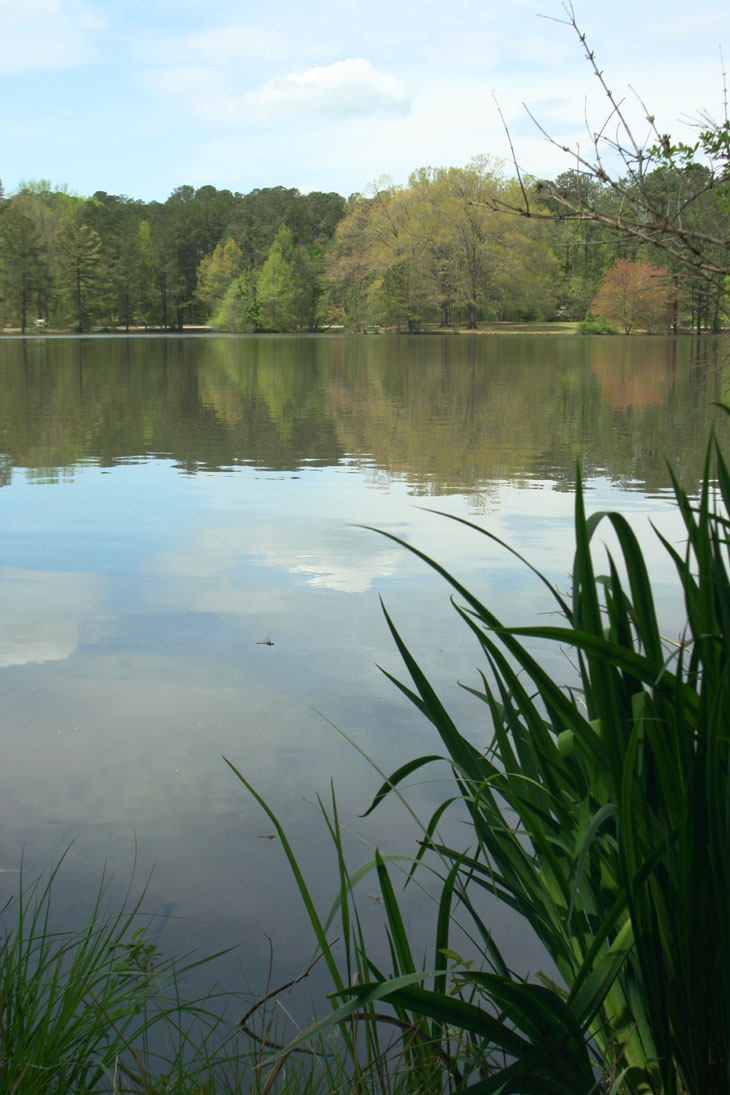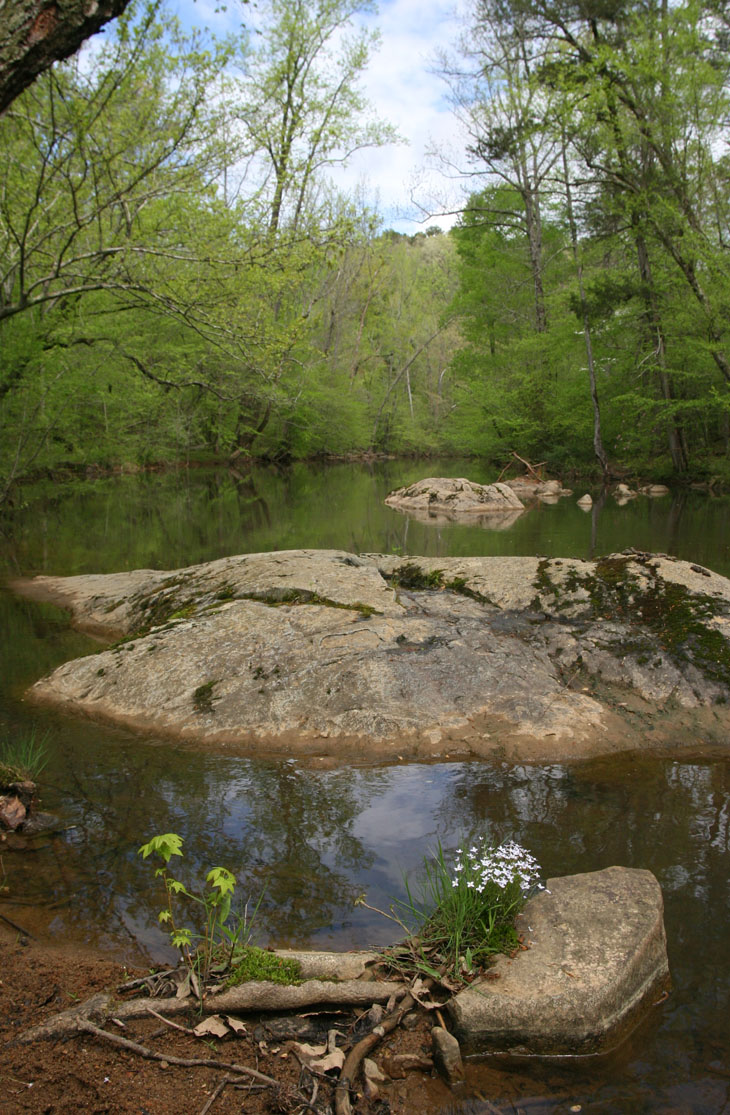
I am making progress on various projects, which is good, but it means posting is slow, and since you’re reading this I can apologize to you. Some of these projects should produce things of potential interest a little later on, so there’s also that, right?
Anyway, I got out yesterday with the extraordinary Al Bugg to check out a couple of areas, one of which I hadn’t been to in a while: Duke Forest. Well, that label actually applies to several noncontiguous patches of forest across two different counties, but it’s still accurate. This section of it was bisected by New Hope Creek, a portion of which you see above. Spying the wildflowers on the bank and getting some sudden blue sky right before this image was taken, I had to go for it.
Now compare it with this one:

Same scene, about 5 meters farther back, but aimed downwards slightly to catch that tiny splash of bright color from the lone iris, thus eliminating the sky. Presents a whole different feel, doesn’t it? Neither one actually has direct sunlight in there, since a small cloud had temporarily blocked the sun in the immediate area, but the lower one communicates this more without the sky or the reflection thereof in the water, and seems like it’s a bit deeper in the woods. Isn’t it fun how you can make subtle adjustments and change the mood of the image?
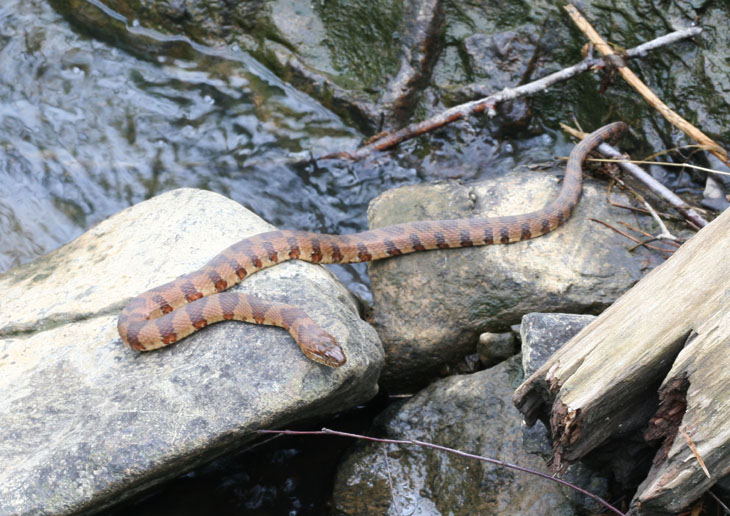
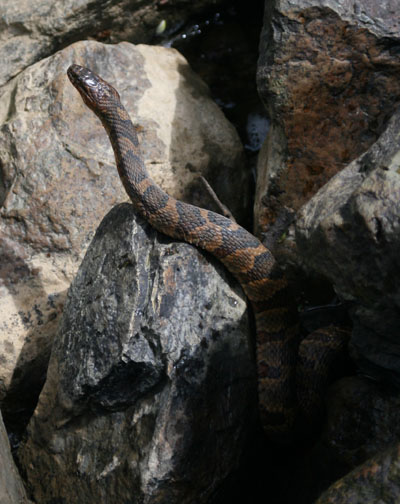 If you’re looking for water snakes in central NC, this is the place to go – I’m not sure I’ve ever been here during their active months and not seen a snake. These are both northern water snakes (Nerodia sipedon,) which tend to be large, impressive snakes, almost always less than a meter in length but sometimes as thick as my wrist. Both were seen from the concrete apron that crosses the creekbed, which yesterday was showing the effects of the recent rains in that the creek was spilling over the top up to 15 cm deep. These two images give a faint impression of how hard it is to illustrate snake markings; even though they’re the same species, you can see the difference in coloration, and the brightness can vary even more than this, partially due to genetics, but also due to how long it has been since the last time the individual has shed its skin – they’re darkest when due, and brightest immediately afterward. It also varies depending on how long they’re been out of the water, appearing brightest when wet. Not far from here, we also saw a queen snake (Regina septemvittata, what a great name,) which is considerably less impressive in appearance though similar in behavior.
If you’re looking for water snakes in central NC, this is the place to go – I’m not sure I’ve ever been here during their active months and not seen a snake. These are both northern water snakes (Nerodia sipedon,) which tend to be large, impressive snakes, almost always less than a meter in length but sometimes as thick as my wrist. Both were seen from the concrete apron that crosses the creekbed, which yesterday was showing the effects of the recent rains in that the creek was spilling over the top up to 15 cm deep. These two images give a faint impression of how hard it is to illustrate snake markings; even though they’re the same species, you can see the difference in coloration, and the brightness can vary even more than this, partially due to genetics, but also due to how long it has been since the last time the individual has shed its skin – they’re darkest when due, and brightest immediately afterward. It also varies depending on how long they’re been out of the water, appearing brightest when wet. Not far from here, we also saw a queen snake (Regina septemvittata, what a great name,) which is considerably less impressive in appearance though similar in behavior.
Both of these species are harmless to humans, but the ones in the photos here are occasionally mistaken for cottonmouths (Agkistrodon piscivorus) or copperheads (Agkistrodon contortrix.) The former is somewhat understandable, since the marking differentiation can be pretty subtle, but the latter borders on ludicrous if you’re ever seen both species. In fact…
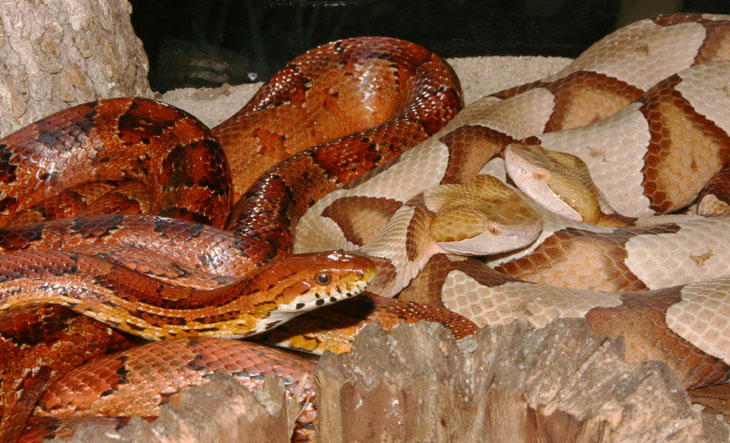
Copperheads are to the right, with a corn snake (Pantherophis guttatus) to the left – this was shot in a terrarium at the NC Aquarium at Fort Fisher. Note not just the coloration, but the shape of the head, and you can see another image of the species from directly above here. I mean, c’mon…
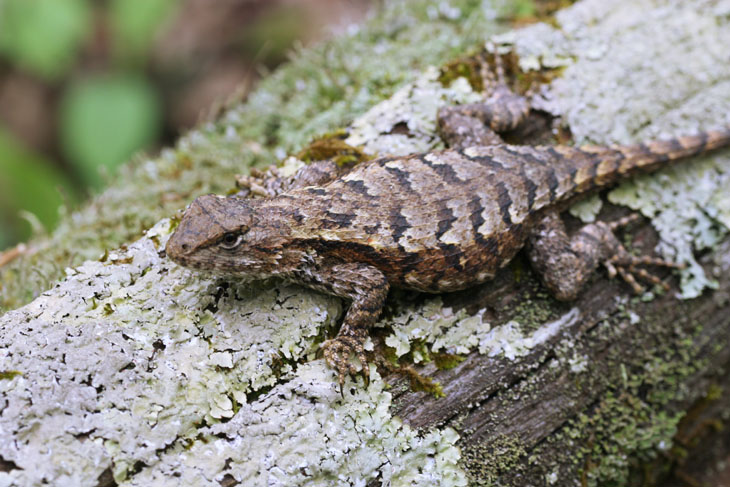
We also came across perhaps the largest eastern fence lizard (Sceloporus undulatus) that I’ve seen, looking like it measured 5 cm across the midriff. They’re wonderfully thorny-looking lizards, but most times their camouflage against the tree trunks and logs is so adept that they won’t be spotted unless they move. This one, however, might have been hungry and so was willing me to creep in a little closer…
 We hadn’t really exhausted all of the possibilities of Duke Forest, but I had an errand to run, so after that we went back to Mason Farm Preserve for a short while, where I stuck to fartsy images, like getting into Morgan Creek and taking this frame down just above water level. I’m shooting with a Canon 30D, which doesn’t have a fancy swing-out LCD or real-time display (old-fashioned optical viewfinder – I know, right?) so this one was shot blind. Except for a slight tweak back to level, this is the perspective I was after.
We hadn’t really exhausted all of the possibilities of Duke Forest, but I had an errand to run, so after that we went back to Mason Farm Preserve for a short while, where I stuck to fartsy images, like getting into Morgan Creek and taking this frame down just above water level. I’m shooting with a Canon 30D, which doesn’t have a fancy swing-out LCD or real-time display (old-fashioned optical viewfinder – I know, right?) so this one was shot blind. Except for a slight tweak back to level, this is the perspective I was after.
Foliage is, finally, getting in thick enough not to look bare, which means lots more to shoot – only two weeks ago I believe, we brought a bunch of plants indoors because of an overnight frost warning, so it almost seems odd to be knee-deep in the hoopla creek in shorts and sandals – the water is still a little chilly, but nothing a hardcore nature photographer can’t handle.
On the banks of just about every body of water I come across larger than a puddle, the frogs are basking – the overall rule is I never see them until they leap into the water to escape, sometimes with a startled-sounding squeak. I will work on getting closer to them in the coming days, quite possibly by going out at night with a headlamp and spotting them that way; this is often confusing enough to them that they don’t move, because it fails to trigger the criteria they have that spells out “hazard” to them. We’ll see what happens.
Now, I know what you’re saying. “Where are all the spiders, Al? How come you’re not posting photo after photo of some arthropod doing something icky?” I hear ya, and be cool, they’re coming – with the foliage comes the bugs, and I already have several such images waiting their turn. Sometimes you have to mix things up a bit, you know?
And so, I’ll close with a photo from the side of the pond, pretty much the exact same place as the lightning photos from just over a week ago, though considerably closer to the ground. It even has an insect in it, so I haven’t forgotten you.
